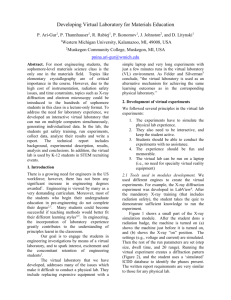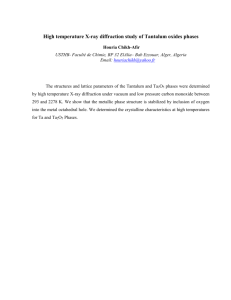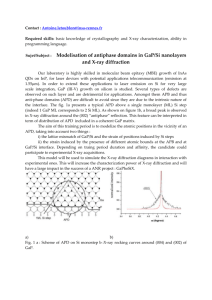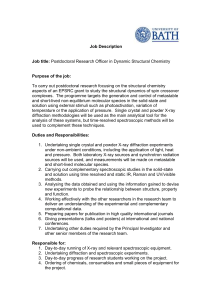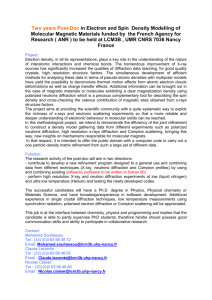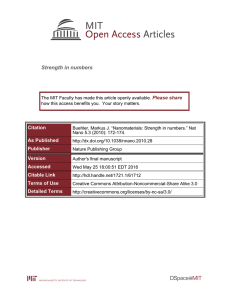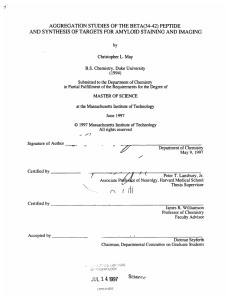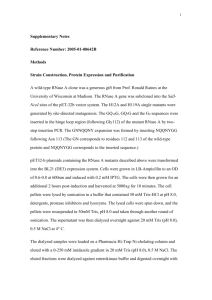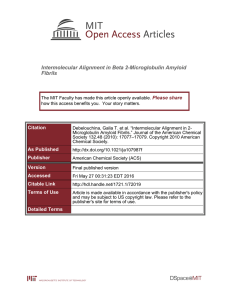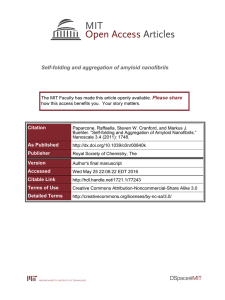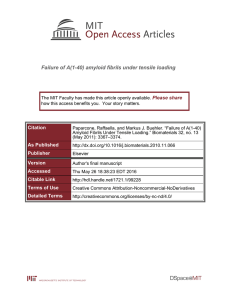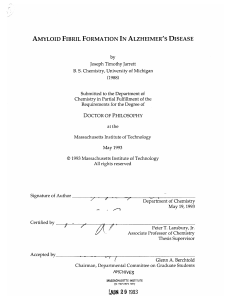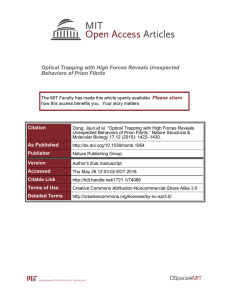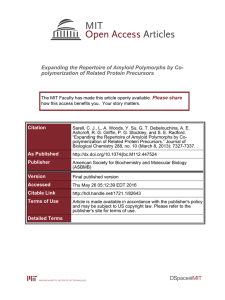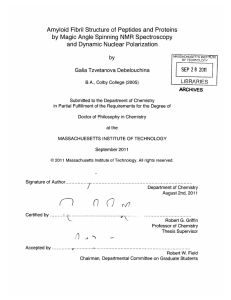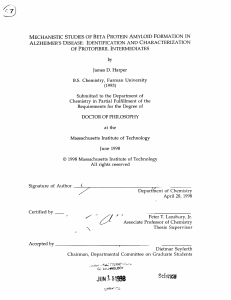bip22650-sup-0001-suppinfo
advertisement
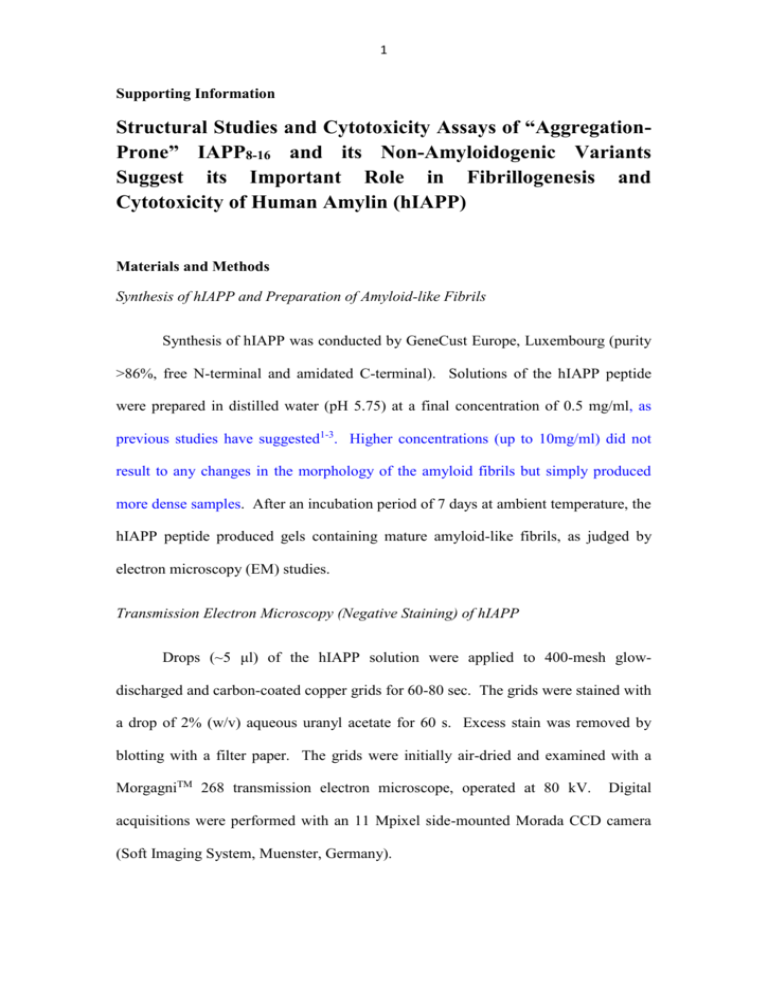
1 Supporting Information Structural Studies and Cytotoxicity Assays of “AggregationProne” IAPP8-16 and its Non-Amyloidogenic Variants Suggest its Important Role in Fibrillogenesis and Cytotoxicity of Human Amylin (hIAPP) Materials and Methods Synthesis of hIAPP and Preparation of Amyloid-like Fibrils Synthesis of hIAPP was conducted by GeneCust Europe, Luxembourg (purity >86%, free N-terminal and amidated C-terminal). Solutions of the hIAPP peptide were prepared in distilled water (pH 5.75) at a final concentration of 0.5 mg/ml, as previous studies have suggested1-3. Higher concentrations (up to 10mg/ml) did not result to any changes in the morphology of the amyloid fibrils but simply produced more dense samples. After an incubation period of 7 days at ambient temperature, the hIAPP peptide produced gels containing mature amyloid-like fibrils, as judged by electron microscopy (EM) studies. Transmission Electron Microscopy (Negative Staining) of hIAPP Drops (~5 μl) of the hIAPP solution were applied to 400-mesh glowdischarged and carbon-coated copper grids for 60-80 sec. The grids were stained with a drop of 2% (w/v) aqueous uranyl acetate for 60 s. Excess stain was removed by blotting with a filter paper. The grids were initially air-dried and examined with a MorgagniTM 268 transmission electron microscope, operated at 80 kV. Digital acquisitions were performed with an 11 Mpixel side-mounted Morada CCD camera (Soft Imaging System, Muenster, Germany). 2 Congo Red Staining and Polarized Light Microscopy of hIAPP Films were formed by applying drops of the hIAPP solution to glass slides and subsequently air-dried at ambient temperatures and humidity. The films were then stained with a 1% Congo red solution in distilled water (pH 5.75) for 20 minutes, following the typical Romhanyi protocol4, as previously shown5,6. Excess stain was removed through tap water washes4. Samples were observed under bright field illumination and between crossed polars, using a Leica MZ75 polarizing stereomicroscope equipped with a JVC GC-X3E camera. X-ray Fiber Diffraction of hIAPP Droplets (10 μl) of the hIAPP peptide solution were placed between two aligned capillaries with wax-covered ends (spaced 2 mm apart). The droplets were allowed to dry slowly at ambient temperature and humidity, for 30-60 min in order to form an oriented fiber suitable for X-ray diffraction. The X-ray diffraction pattern was collected, using a SuperNova-Agilent Technologies X-ray generator equipped with a 135-mm ATLAS CCD detector and a 4-circle kappa goniometer, at the Institute of Biology, Medicinal Chemistry and Biotechnology, National Hellenic Research Foundation (CuKα high intensity X-ray micro-focus source, λ=1.5418 Å), operated at 50kV, 0.8mA. The specimen-to-film distance was set at 52 mm. The exposure time was set to 360s. The X-ray diffraction pattern was initially viewed using the program CrysAlisPro7 and subsequently displayed and measured with the aid of the program iMosFLM8. 3 Cytotoxicity Assays Human PANC-1 cells (derived from a patient with epithelioid carcinoma in the pancreatic duct) were plated in 96-well plates at a density of 5 x 103 cells/well. Cells were incubated for 24h in Dulbecco’s Modified Eagle’s Medium (DMEM) supplemented with 10% fetal bovine serum (FBS) at 37o in 5% CO2. Stock solutions of hIAPP were prepared in ddH20 at a concentration of 0.5 mg/ml, similar to that used in the biophysical studies, in order to keep track of the aggregation propensity of the peptide. Peptide toxicity was assessed after 1, 7 and 14 days of incubation, respectively. The final concentration of the peptide in the culture medium was set to 5μM, based on similar previous cytotoxicity assays9-12. The MTT dye (1 mg/ml in phenol red free DMEM w/o FBS) was added 24h after the addition of the peptides. Reduction of the dye by living cells was allowed to take place for 3-4h. The MTT solution was discarded and isopropanol was added to dissolve the formazan crystals. Absorbance of the solution was measured at 570nm wavelength. Survival of nontreated cells was set to 100%. 4 Figure S1. The amyloidogenic profile of hIAPP as predicted by (A) AmylPred and (B) AmylPred213,14. Both algorithms successfully predict high aggregation potency for the extensively studied 13-20 and 20-29 segments of hIAPP, however also indicate a smaller aggregation propensity for residues 8-10. Introduction of mutations L12R (red line) and L12P (green line) significantly decrease the overall amyloidogenic potential of the 8-16 region of wild type hIAPP (blue line). 5 Figure S2. Amyloidogenic properties of full length hIAPP. (A) Amyloid fibrils formed by hIAPP appear as straight and unbranched double helices (arrows), with an indeterminate length and a diameter of approximately 100-120 Å, as also previously shown15,16, indicating a comparable similarity in morphology to the fibrils formed by the IAPP8-16 peptide. Scale bar 200nm. (B) X-ray diffraction pattern produced by an oriented fiber containing more or less aligned amyloid fibrils of hIAPP. A strong 4.7 Å meridional reflection (M) corresponds to the repeat distance of β-strands aligned perpendicularly to the fiber axis, whereas the 10.1 Å equatorial (E) reflection is attributed to the packing distance between β-sheets. Similar reflections were recorded in the case of IAPP8-16 peptide, indicating comparable similarities in the “cross-β” structure of amyloid fibrils produced in both cases. (C) Gel containing amyloid fibrils formed by self-assembly of hIAPP, positively stained with the Congo red dye, as seen under bright field illumination. (D) Under crossed polars, an apple/green birefringence, characteristic of amyloids, is clearly evident. Scale bars 1000μm. Figure S3. Cytotoxicity assays of hIAPP after incubation for 1, 7 and 14 days, respectively. Results clearly indicate that hIAPP has enhanced cell toxicity even after 1 day of incubation (~40% cell viability). 6 References 1. 2. 3. 4. 5. 6. 7. 8. 9. 10. 11. 12. 13. 14. 15. 16. Higham, C.E.;Jaikaran, E.T.;Fraser, P.E.;Gross, M.;Clark, A. FEBS Lett. 2000, 470, 55-60. Padrick, S.B.;Miranker, A.D. J. Mol. Biol. 2001, 308, 783-794. Goldsbury, C.;Goldie, K.;Pellaud, J.;Seelig, J.;Frey, P.;Muller, S.A.;Kistler, J.;Cooper, G.J.;Aebi, U. J. Struct. Biol. 2000, 130, 352-362. Romhanyi, G. Virchows Arch. A Pathol. Anat. Histopathol. 1971, 354, 209-222. Louros, N.N.;Iconomidou, V.A.;Giannelou, P.;Hamodrakas, S.J. PLoS ONE 2013, 8, e73258. Louros, N.N.;Petronikolou, N.;Karamanos, T.;Cordopatis, P.;Iconomidou, V.A.;Hamodrakas, S.J. Biopolymers 2014. Oxford, 2009. Chrysalis Promotions, in: Diffraction, (Ed.), Oxford Diffraction Ltd., Abingdon, Oxfordshire, England. Leslie, A.G.W.;Powell, H.R., 2007. Processing Diffraction Data with Mosflm, p. 4151, in: Read, R;Sussman, J L, Eds.), Evolving Methods for Macromolecular Crystallography, Springer, Dordrecht, The Netherlands, Vol. 245, pp. 41-51. Scrocchi, L.A.;Ha, K.;Chen, Y.;Wu, L.;Wang, F.;Fraser, P.E. J. Struct. Biol. 2003, 141, 218-227. Lopes, D.H.;Colin, C.;Degaki, T.L.;de Sousa, A.C.;Vieira, M.N.;Sebollela, A.;Martinez, A.M.;Bloch, C., Jr.;Ferreira, S.T.;Sogayar, M.C. J. Biol. Chem. 2004, 279, 42803-42810. Ritzel, R.A.;Jayasinghe, S.;Hansen, J.B.;Sturis, J.;Langen, R.;Butler, P.C. Regul. Pept., 165, 158-162. Muthusamy, K.;Albericio, F.;Arvidsson, P.I.;Govender, P.;Kruger, H.G.;Maguire, G.E.;Govender, T. Biopolymers, 94, 323-330. Frousios, K.K.;Iconomidou, V.A.;Karletidi, C.M.;Hamodrakas, S.J. BMC Struct. Biol. 2009, 9, 44. Tsolis, A.C.;Papandreou, N.C.;Iconomidou, V.A.;Hamodrakas, S.J. PLoS ONE 2013, 8, e54175. Goldsbury, C.;Kistler, J.;Aebi, U.;Arvinte, T.;Cooper, G.J. J. Mol. Biol. 1999, 285, 33-39. Goldsbury, C.;Goldie, K.;Pellaud, J.;Seelig, J.;Frey, P.;Muller, S.A.;Kistler, J.;Cooper, G.J.;Aebi, U. J. Struct. Biol. 2000, 130, 352-362.



